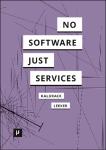Search
Author
- Jorgensen, Ed (3)
- McFadyen, Ron (3)
- Linge, Svein (2)
- Abramson, David (1)
- next >
Subject
- programming (8)
- Java (6)
- Programming (5)
- Computer science (4)
- next >
Date issued
Has File(s)
- true (39)
Search Results
The purpose of this text is to provide a reference for University level assembly language and systems programming courses. Specifically, this text addresses the x86-64 instruction set for the popular x86-64 class of processors using the Ubuntu 64-bit Operating System (OS). While the provided code and various examples should work under any Linux-based 64-bit OS, they have only been tested under Ubuntu 14.04 LTS (64-bit). The x86-64 is a Complex Instruction Set Computing (CISC) CPU design. This refers to the internal processor design philosophy. CISC processors typically include a wide variety of instructions (sometimes overlapping), varying instructions sizes, and a wide range of addressing modes. The term was retroactively coined in contrast to Reduced Instruction Set Computer (RISC... |
"We set out to design an introductory course governed by four themes:
Give students a good idea of what a career in MIS looks like by doing MIS.
Enhance the professionalism of deliverables by teaching design and usability concepts.
Promote creativity by assigning projects that demand it.
Teach students about cloud computing by having them do cloud computing.
Students in an introductory Management Information Systems (MIS) course often ask what a career in MIS looks like. Lacking a clear vision, they make their own assumptions. Often they assume the career involves programming with little human interaction. That MIS is a technical field could not be further from the truth. MIS job descriptions typically require candidates to be able to collaborate, communicate, analyze needs a... |
Computers are everywhere in our daily lives. Between the desktop, laptop, phone, bank, and vehicle, it is difficult to completely get away from computers. It only makes sense to learn a little about how a computer really works.This text provides an introduction to programming and problem solving using the Fortran 95/2003/2008 programming language. This introduction is geared for non-computer science majors. The primary focus is on an introduction to problem solving and algorithm development. As such, many details of the Fortran 95/2003/2008 language are omitted. |
"The title of this book was originally Think Perl 6, but since Perl 6 has been renamed Raku, we have also changed the title of the book.
Think Raku is an introduction to computer science and programming intended for people with little or no experience.
This aim of this book is not primarily to teach Raku, but instead to teach the art of programming, using the Raku language. After having completed this book, you should hopefully be able to write programs to solve relatively difficult problems in Raku, but my main aim is to teach computer science, software programming, and problem solving rather than solely to teach the Raku language itself.
Think Raku is a free book available under a Creative Commons license. Readers are free to copy and distribute the text; they are also ... |
There are a number of excellent, comprehensive, and in-depth texts on MIPS assembly language programming. This is not one of them.The purpose of this text is to provide a simple and free reference for university level programming and architecture units that include a brief section covering MIPS assembly language programming. The text assumes usage of the QtSpim simulator. An appendix is included that covers the download, installation, and basic use of the QtSpim simulator.The scope of this text addresses basic MIPS assembly language programming including instruction set usage, stacks, procedure/function calls, QtSpim simulator system services, multiple dimension arrays, and basic recursion. |
This book is Part I of a two-part set that introduces the Java programming language. The text assumes the student will be using the BlueJ development environment and provides some introductory BlueJ material. Our experience has been that BlueJ is easy to learn and provides a good programming environment for the beginner programmer. |
"Welcome to the Eighth Edition of Introduction to Programming Using Java, a free, on-line textbook on introductory programming, which uses Java as the language of instruction. This book is directed mainly towards beginning programmers, although it might also be useful for experienced programmers who want to learn something about Java. It is not meant to provide complete coverage of the Java language.
The eighth edition requires Java 8 or later, and it uses JavaFX for GUI programming. Version 8.1 is a small update of Version 8.0. This version briefly covers some of the new features in Java 11 and makes it clearer how to use this book with Java 11 and later." |
Platform Embedded Security Technology Revealed is an in-depth introduction to Intel’s platform embedded solution: the security and management engine. The engine is shipped inside most Intel platforms for servers, personal computers, tablets, and smartphones. The engine realizes advanced security and management functionalities and protects applications’ secrets and users’ privacy in a secure, light-weight, and inexpensive way. Besides native built-in features, it allows third-party software vendors to develop applications that take advantage of the security infrastructures offered by the engine.
Intel’s security and management engine is technologically unique and significant, but is largely unknown to many members of the tech communities who could potentially benefit from it. Plat... |
Is software dead? Services like Google, Dropbox, Adobe Creative Cloud, or Social Media apps are all-pervasive in our digital media landscape. This marks the (re)emergence of the service paradigm that challenges traditional business and license models as well as modes of media creation and use. The short essays in this edited collection discuss how services shift the notion of software, the cultural technique of programming, conditions of labor as well as the ecology and politics of data and how they influence dispositifs of knowledge. |
Introduction about Computer Science is about problem solving, Computing Basics. Basics, conditionals, loops, functions, erros handling, Arrays, Collections & Dynamic Memory, strings, file input/output. The PHP Programming Language |










